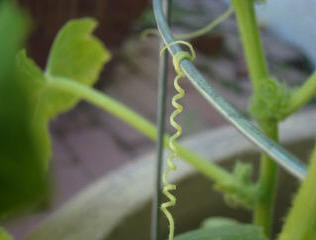(7/3) Something cool is happening under your nose….if you grow cucumbers, that is. We all know that cucumbers require support for the best growth and production. We have all witnessed the cucumber sending out tendrils, the modified plant tissue that cucumbers use to latch onto support so they can climb toward the sun. We have all seen those long, flexible tendrils
transform overnight into tightly bound spirals like the curls on Shirley Temple’s forehead. What you may not have noticed, is that tendrils spiral to the left at one end of the attachment, and to the right at the other.
Tendrils are sensitive to touch, also know as prehensile, for those looking to increase their lexicon. If a tendril touches upon something that is the right shape, it will wrap itself around that support. There is a layer of tissue exactly two cells deep called gelatinous tissue. The architecture of these cell walls allows the tissue to either elongate or contract,
which makes it possible for the tendril to form a helix. One might assume that the tendrils curl in only one direction, similar to a holiday curling ribbon, but they don’t. The helix will spiral to the right at one point of attachment and to the left at the other. The benefit to the cucumber is that it allows for gentle movement and flexibility as the tender parts of the
plant are getting established. More importantly, the effect of the tendrils curling in two directions is that it causes the spirals to tighten rather than straighten when the ends of the tendrils are pulled apart.
 Young tendrils are controlled by gelatinous tissue. This allows the plant tissue to morph from long, seeking strands into tightly curled supports that are both strong and flexible. Over time, the tendrils become more rigid. This happens because the cells on the interior of the tendril contain lignin, a
substance that provides strength and rigidity to the plant structure. As the tendrils age, they lose moisture and the effect of the lignin comes to dominate the character of the tendril. At this point, the tendrils are locked in place to solidify the older, more mature parts of the plant to a support structure. Meanwhile, the youngest tissue continues to reach for the sun
and seek new places to grab a hold with tight spirals.
Young tendrils are controlled by gelatinous tissue. This allows the plant tissue to morph from long, seeking strands into tightly curled supports that are both strong and flexible. Over time, the tendrils become more rigid. This happens because the cells on the interior of the tendril contain lignin, a
substance that provides strength and rigidity to the plant structure. As the tendrils age, they lose moisture and the effect of the lignin comes to dominate the character of the tendril. At this point, the tendrils are locked in place to solidify the older, more mature parts of the plant to a support structure. Meanwhile, the youngest tissue continues to reach for the sun
and seek new places to grab a hold with tight spirals.
If you have not planted cucumbers in the garden this year, there is still time, but not much. Early July is your last opportunity to plant them if you want to actually eat cucumbers and not just watch tendril magic. If you don’t have cucumbers growing in your garden but your neighbor offers you some of their bounty, don’t just settle for the gift of the harvest.
Request to see the plant too. Take the time to look at the young tendrils searching for a support. Notice the tight spirals of the tendril and how they twirl in different directions at either end with a kink in the middle. Appreciate the strength and flexibility of the young tendrils and the stability of the older, drier tendrils. The magic of the cucumber tendril is
fascinating (a.k.a. cool). It is not something to be missed.